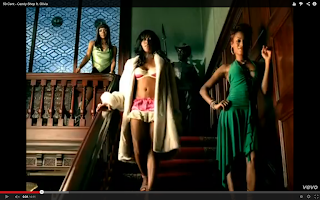For example: hip-hop
50 Cent - Candy Shop: Recurring themes of money, women (male gaze) and power. Artist lip syncing, surrounded by females.
Kendrick Lamar - Swimming Pools (Drank): general theme of partying and the metaphor of falling into swimming pools. Less male gaze (this screenshot is one of the only cuts featuring a female in the whole video), but there's still the standard 'generic female' featured. Artist lip syncing during some scenes, but not all.
Drake - Started From the Bottom: As one can see in the screenshot above, this video is based around the theme of power and money, as well as an element of male gaze. This video almost perfectly fits in with the hip-hop version of Goodwin's idea of genre characteristics.
There are some hip-hop videos, however, that don't particularly fit these genre characteristics. A typical example of this is Kanye West's low-key black and white video for Black Skinhead, which is mostly animated, only featuring animations and recordings of Kanye himself. This video also doesn't feature any male gaze, and doesn't really contain any elements of money or power, although there is more of the latter than anything else.











